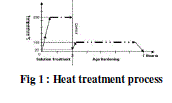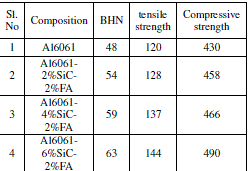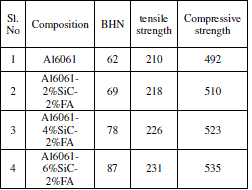ISSN ONLINE(2319-8753)PRINT(2347-6710)
ISSN ONLINE(2319-8753)PRINT(2347-6710)
Sridhar Bhat 1, B.S.Mahesh 2
|
| Related article at Pubmed, Scholar Google |
Visit for more related articles at International Journal of Innovative Research in Science, Engineering and Technology
Small pieces of alloy were placed in the crucible. preheated silicon carbide (SiC) And Fly Ash(FA) was used as the reinforcements. produced by stir casting process. Cut pieces of alloy Al6061 were preheated at 450 °C for 1h before melting. Firstly SiC and Fly Ash particles were heated at 8000C for 2 hrs. before adding preheated SiC and Fly Ash particles in to Al6061 melt, 1Wt% of Mg is added to melt to improve the wettability between matrix and reinforcement. The furnace temperature was raised above the liquidus temperature to melt the alloy completely and care was taken to maintain the temperature of the melt at 7100C. The literature survey suggests formation of Al4C3 in Al-SiC composites which were produced by stir casting at higher temperature. In the present study EDS analysis confirmed nil presence of any such faces. Mechanical mixing was carried out about 7 minutes at an average stirring speed of 350 rpm during mixing processes at a controlled temperature within 710 °C. The pouring temperature was controlled to be around 700°C. A preheated permanent mould with diameters in the range of 10 mm and 25 mm was used to prepare cast bars.
Keywords |
| Silicon carbide,fly ash,metal matrix composite,alumenium matrix composite,ageing,scanning electron microscope,wettability,energy disperion analysis. |
INTRODUCTION |
| The composite material can be defined as the system of material consisting of a mixture of combination of two or more micro constituents insoluble in each other and differing in form and or in material composition .These materials can be prepared by putting two or more dissimilar material in such way that they function mechanically as a single unit. The properties of such materials differ from those of their constituents. These materials may have a hard phase embedded in a soft phase or vice versa. Normally in the composite material have a hard phase in the soft ductile matrix where the hard phase act as a reinforcing agent increase the strength and modulus, and soft phase act as matrix material. The requirement for satisfying the above mentioned condition is a). The composite material has to be man-made, b). The composite material must be a combination of at least two chemically distinct materials with an interface separating the components. |
| Following are the main objectives of the present work : |
| 1. To fabricate Hybrid MMCs containing Al6061 as matrix material and SiC reinforcement varying the SiC percentages from 2, 4, 6% keeping FA Wt% to constant 2% using stir casting method. |
| 2. To improve wettability magnesium powder is added into the melt |
| 3. To characterize Al6061, Al6061-2%SiC-2%FA, Al6061-4%SiC-2%FA, Al6061-6%SiC-2%FA by optical image analyzer, SEM/EDS microanalysis. |
| 4. To study interfacial reactions between reinforcement and matrix using SEM/EDS analysis. |
| 5. To study mechanical and micro structural properties of above fabricated composites before and after Heat treatment. |
| K.L. Meena et al. presented a paper on “An Analysis of Mechanical Properties of the Developed Al/SiC-MMC's”[31] and finds that Optical micrographs shows reasonably uniform distribution of SiC particles. Tensile strength increases with the increase in reinforced particulate size and weight fraction of SiC particles. Also % Elongation and % Reduction in area decreases with the increase in reinforced particulate size and weight fraction of SiC particles. Hardness (HRB) and Density increases with the increase in reinforced particulate size and weight fraction of SiC particles. Impact Strength decreases with the increase in reinforced particulate size and increases with the increase in weight fraction of SiC particles. |
| K. Radhakrishna et al, he had used aluminium with copper and fly ash as reinforcements and concluded that up to 15% the reinforcements are successfully dispersed in the matrix and hardness, wear resistance increases up to 15 wt% addition of reinforcements. |
| Beinias et al, used aluminium with fly ash as reinforcements and stated with the addition of fly ash brittleness increases and corrosion increases as it forms porosity. |
| Hebbar et al, made use of aluminium and fly ash composite material for their testing and concluded that compression tension and hardness property increases with addition of fly ash to the aluminium matrix. |
| Shanmugsundaram et al, stated that beyond 20% of addition of fly ash leads to mismatch between the theoretical and measured density values due to increased porosity and particle cluster. |
| Anil kumar et al, concluded that with addition of fly ash impact strength increases up to some extinct. |
| Sudarshan et al, have synthesized A356 Al–fly ash particle composites .They studied mechanical properties and dry sliding wear and come into brief idea that the damping capacity of composite increases with the increase in volume fraction of fly ash. The 6% of fly ash particles into A356 Al alloy shows low wear rates at low loads (10 and 20 N) while 12% of fly ash reinforced composites show lower wear rates compared to the unreinforced alloy in the load range 20–80 N. At higher load, subsurface delamination is the main mechanism in both the alloy as well in composites. S. C. Mishra et al, and co workers has studied on Aluminum – fly ash composite produced by impeller mixing and came into a brief idea that Up to 17wt% fly ash reinforcement can be reinforced by liquid metallurgy route. The addition of magnesium into the aluminium melt increase the wettability and thus increase in the mechanical properties such as hardness, tensile strength and the wear resistance is observed. |
| Basavaraju S et al, in his work utilized LM25 aluminium as base metal and SiC (2, 4, 6 and 8 %), 2% fly ash and 2% graphite as reinforcements. And stated that 2% sic and 2% fly ash is the best combination of reinforcement for best results and the higher wear rate is measured at 8% sic. |
| Gaurau saini et al, used Al6061 as base metal and silicon carbide (2.5%, 5% and 10%) as reinforcement. And mentioned that an increasing trend of tensile test with increasing in weight percentage of sic had been observed. Mahesh V [10] et al, in his paper tensile strength experiments have been conducted by varying mass fraction of SiC (5%, 10%, 15% and 20%) with aluminium. The maximum tensile strength has obtained at 15% Sic ratio. |
| J.Jenix Rino, D.Chandramohan, K.S.Sucitharan presented a paper on “An Overview on Development of Aluminium Metal Matrix Composites with Hybrid Reinforcement”[35] in which they reveals that aluminium alloy matrix composites reinforced with Hybrid can be successfully synthesized by the stir casting method. With the addition of hybrid reinforcement instead of single reinforcement the hardness, toughness, strength, corrosive and wear resistance of the composite will be further increased. |
COMPOSITE PREPARATION |
| Small pieces of alloy were placed in the crucible. preheated silicon carbide (SiC) And Fly Ash(FA) was used as the reinforcements. Composites were produced by stir casting process. Melting was carried out in a graphite crucible in a PLC resistance furnace. Cut pieces of alloy Al6061 were preheated at 450 °C for 1h before melting. Firstly SiC and Fly Ash particles were heated at 8000C for 2 hrs. before adding preheated SiC and Fly Ash particles in to Al6061 melt, 1Wt% of Mg is added to melt to improve the wettability between matrix and reinforcement. The furnace temperature was raised above the liquidus temperature to melt the alloy completely and care was taken to maintain the temperature of the melt at 7100C. The literature survey suggests formation of Al4C3 in Al-SiC composites which were produced by stir casting at higher temperature. In the present study EDS analysis confirmed nil presence of any such faces. Mechanical mixing was carried out about 7 minutes at an average stirring speed of 350 rpm during mixing processes at a controlled temperature within 710 °C. The pouring temperature was controlled to be around 700°C. A preheated permanent mould with diameters in the range of 10 mm and 25 mm was used to prepare cast bars. The preheating temperature 250 °C for steel mould was maintained for slower cooling. Finally the super-heated melt was poured into the steel mould. Metallographic samples were sectioned from the cast bars. A 0.5% HF solution was used to etch the samples wherever required. |
HEAT TREATMENT |
| The cast Al6061 matrix alloy and Al6061-SiCp Fly ash hybrid particulate composites were subjected to solutionizing treatment at a temperature 530 0 C for a period of 2 h using muffle furnace, followed by quenching in Ice. Artificial ageing treatment was carried out for a duration of 2 h to 10 h in steps of 2 h at a temperature of 1750 c. Metallographic, density, and hardness, compressive tensile tests were carried out on both unheated and heat treated specimens. |
 |
RESULTS AND DISCUSSIONS |
IV. Microstructure and image analysis: |
| Microstructures of the cast composites were examined in a metallurgical microscope at different magnifications for the presence of various phases (as shown in below Fig 2). The major phases are primary α-Al, eutectic structures and secondary SiC and Fly-ash particles. Extensive care was taken to avoid porosity and porosity levels of the as–cast composites were measured to be negligible since the composite melt was degassed and casting was carried out in argon atmosphere. Owing to the selection of the proper stirrer and the stirring speed, a homogeneous distribution of particles in the cast samples resulted. |
 |
| Microstructure studies clearly reveal that uniform distribution of SiC and fly ash particles in matrix in both as cast and heat treated hybrid composites shows excellent bond between matrix and the reinforcement. it is observed that a refinement of grain size is seen at higher percentage of reinforcement. It is shown in below Fig 3. |
 |
| When % of SiC is increased in both before and after heat treatment sample it is observed that a refinement of grain size is seen at higher percentage of reinforcement. It can also be seen in Fig 4. That grain structure of the alloys are equiaxed in shape which attributes to the effect of stirring and the speed of the stirrer which tries to breaks the dendrite shaped structure. |
 |
| Microstructures of without heat treated and heat treated Al6061-SiC-FA hybrid composites are shown in Fig. It is observed that there is homogeneity in the distribution of the reinforcement in the matrix alloy refinement of grain size A refinement of grain size is seen at higher percentage of reinforcement. It is shown in below fig 5. |
 |
| Examinations of these materials in the heat treated state indicate to the reduction of the presence and size of the intermetallic precipitations. Due to the heat treatment performed the precipitations get dissolved in the solid solution in the quenching process. |
| It is observed that fine intermetallics of Mg2Si are formed within the matrix alloy on heat treatment. Ageing duration do dictate the extent of formation of these intermetallics. 8hrs of ageing has resulted in higher extent of formation of these intermetallics. The extent of formation of these intermetallics can be attributed to the fact that on ice quenching the rate of cooling during quenching process is very high which enhances the ageing kinetics. |
SEM |
| Fig 6 shows SEM images of Hybrid MMCs. SEM images of exhibits good interfacial bond between matrix and reinforcement and also improves mechanical properties. In most cases, the interface is clean and smooth.. Energy dispersion analysis shown in the spectrum shows the presence of both Si and C indicating that the reinforcement is silicon carbide. Several authors reported presence of inter-metallic brittle component such as Al4C3 at the interface between matrix and reinforcement which deteriorates the mechanical properties. EDS analysis confirms the absence of interfacial products such as Al4C3 at the interface. |
 |
MECHANICAL PROPERTIES: |
| From Table 1, it is clear that the hardness of the composites is higher than that of the non-reinforced alloy. Hardness is found to increase with increasing silicon carbide content. The higher hardness of the composites could be attributed to the fact that SiC and FA particles act as obstacles to the motion of dislocation and also the matrix of composites contains higher dislocation density due to mismatch in thermal expansion coefficient between the matrix and the reinforcement. This leads to higher hardness in the composites. Further it is believed that SiC and FA particles being harder than aluminium alloy, the inherent property of hardness is rendered to the soft matrix .The % elongation of the composite decreases as the percentage of the reinforcement content increases in the composite and this appears to be quite obvious from the enhanced hardness associated with higher SiC and Fly Ash content. |
 |
| From Table 2, a maximum of improvement is noticed in heat treated Al6061-65SiC-2%FA Hybrid composite when compared with heat matrix alloy. It is also observed that, heat treatment has profound influence on microhardness of Heat treated Al6061 alloy and Al6061-SiC-FA hybrid composites. All the heat treated samples exhibit higher microhardness values when compared with as untreated alloy and its composites. This can be attributed to the formation of intermetallic precipitates namely Mg2Si from super saturated solid solution.. |
| Table 2, shows the variation of microhardness of as cast Al6061 alloy and Al6061-SiC-FA Hybrid composites with increase in ageing duration. It can be observed that, increase in ageing duration has resulted in increased microhardness for both matrix alloy and its composites. It is also observed that all the composites and matrix alloy exhibit maximum hardness at 6hrs of ageing duration. A maximum improvement of 40.1% is noticed in Al6061–6wt%SiC -2% FA. |
 |
CONCLUSIONS |
| The following conclusion may be drawn from the present work: |
| 1. From the study it is concluded that we can use fly ash for the production of composites and can turn industrial waste into industrial wealth. This can also solve the problem of storage and disposal of fly ash. |
| 2. Cast Al6061 and hybrid composites with varying reinforcement percent have been heat treated (T-6 condition) successfully. |
| 3. Addition of magnesium improves the wettability of fly ash with aluminium melt and thus increases the retention of the SiC and fly ash in the composite |
| 4. Microstructure studies clearly reveal uniform distribution of SiC and fly ash particles in matrix in both as cast and heat treated hybrid composite samples with excellent bond between the matrix and the reinforcement. |
| 5. Average grain size of as cast hybrid composites reduces with addition of SiC and fly ash particles. |
| 6. SEM and EDS analysis confirms absence of unwanted inter-metallic brittle components. |
| 7. Hardness of commercially pure aluminium is increased by 31.25% with addition of fly ash and SiC particles. |
| 8. The Ultimate tensile strength has improved with increase in SiC and fly ash content. |
References |
|